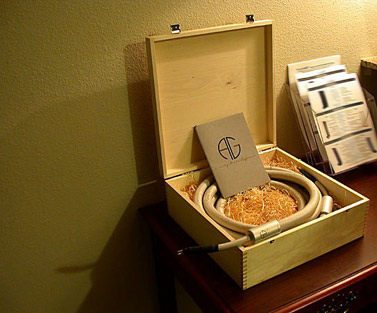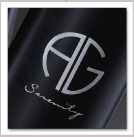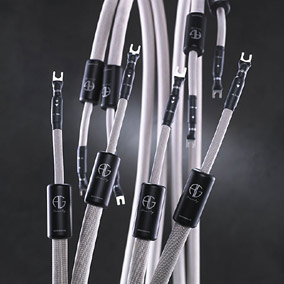Argento Audio Serenity Cables
| Argento Audio Serenity Cables |
| A Reference Cable By Any Standard |
|
|
|
January 2006 |
A Stunning Debut During the 2004 CES, I came across what I thought was one of the most breathtaking looking and sounding set ups I had seen. It was the TMH Audio room which featured electronics from two Danish companies: Argento Audio and Vitus Audio. Vitus Audio provided the room’s electronics including a stunningly gorgeous pair of massively built (and priced – $45,000/pr) amplifiers and an equally lovely preamp. My long time reference, the Electrocompaniet EMC-1 CD player was the digital source and the towering Sound Lab Ultimate-1s were the loudspeakers. Connecting all of this were some fairly massive silver cables dressed in a gorgeous pearl white fabric from Argento Audio.
During the 2004 CES, I came across what I thought was one of the most breathtaking looking and sounding set ups I had seen. It was the TMH Audio room which featured electronics from two Danish companies: Argento Audio and Vitus Audio. Vitus Audio provided the room’s electronics including a stunningly gorgeous pair of massively built (and priced – $45,000/pr) amplifiers and an equally lovely preamp. My long time reference, the Electrocompaniet EMC-1 CD player was the digital source and the towering Sound Lab Ultimate-1s were the loudspeakers. Connecting all of this were some fairly massive silver cables dressed in a gorgeous pearl white fabric from Argento Audio.
After I got done drooling over the sheer physical beauty of this system, I finally settled in for an extended listening session. I had brought a number of live recordings with me and couldn’t wait to hear just how this system was going to reproduce them. I was not disappointed. One track in particular, the Ray Brown Trio’s “Can’t Help Lovin’ Dat Man,” from the Summer Wind: Live At The Loa [Concord], was rendered with an absolutely quiet background that aloud me to hear so deeply into the Sound Labs that it vitually made those nearly 7’ tall behemoths disappear. This is a trick that would make David Copperfield field proud.
Needless to say, I came away with the distinct feeling that in the Vitus Audio electronics and Argento cables that two new players were now in the mix that would make U.S. audio stalwarts take notice.
Their Loss, My Gain
A year after first seeing the Argento/Vitus Audio system, I once again found myself in their room except now it was the 2005 CES. Also, unlike the previous year when the Vitus Audio phono stage and CD player were held up in customs, this year the system was in its full glory and boy did it sound like it. But it occurred to me that in the year that had past, I did not see one Vitus or Argento ad or review in any of the major U.S. audio journals. I would have thought that these folks would have been falling all over each other to get a chance to spend some times with this gear. But a little Chat with Vitus Audio’s Hans Ole Vitus brought out some of the ugly truths about dealing with some U.S. publications. Without naming any one particular person or publication, I’ll just say that I’ve learned that sometimes a person representing a publication will suggest to a manufacturer “things” that they can do to ensure that their product gets reviewed. Vitus, of course, bristled at these suggestions and as a result, Argent/Vitus Audio remained an enigma.
But Vitus, and Argento chief Ulrik Madsen, still sought to gain a presence in the U.S. and even expressed an interest in working with some of the audiophile webzines, webzines like say … the Stereo Times. I didn’t immediately go for the Vitus gear because frankly when I start even thinking about taking on gear that is priced in this stratosphere I begin to get nosebleeds. But the Argento cables, for whatever reason, seemed more accessible, so access them I did.
Define Entry Level Argento has three lines of reference quality silver cables: the top-of-the-line Serenity Master Reference, the Serenity Reference, and their so-called “entry” cables, the Serenity, which is under review here. Now I have to admit that I have a problem with companies putting the label “entry” on their products as if it’s an excuse for being less expensive. The cost, technology, quality of construction, and sonic capabilities of many splendid components these days get smacked down in the audiophile consciousness because they are labeled (often by their own creators) as being an “entry level” product. Such, unfortunately is the case here with the Argento Serenity. With all due respect to Ulrik Madsen, this is not an entry level product. Instead, what you have here is a reference quality line of cables which use Neutrik XLR connectors, Eichmann Silver Bullet RCA plugs, and Furutech AC cord connectors and are easily suitable for the highest quality systems, and at a price that is commensurate with its level of build and performance. And believe me, that level ain’t “entry.”
Argento has three lines of reference quality silver cables: the top-of-the-line Serenity Master Reference, the Serenity Reference, and their so-called “entry” cables, the Serenity, which is under review here. Now I have to admit that I have a problem with companies putting the label “entry” on their products as if it’s an excuse for being less expensive. The cost, technology, quality of construction, and sonic capabilities of many splendid components these days get smacked down in the audiophile consciousness because they are labeled (often by their own creators) as being an “entry level” product. Such, unfortunately is the case here with the Argento Serenity. With all due respect to Ulrik Madsen, this is not an entry level product. Instead, what you have here is a reference quality line of cables which use Neutrik XLR connectors, Eichmann Silver Bullet RCA plugs, and Furutech AC cord connectors and are easily suitable for the highest quality systems, and at a price that is commensurate with its level of build and performance. And believe me, that level ain’t “entry.”
According to the manufacturer the only differences between the Serenity and its larger siblings (the Serenity Reference and Serenity Master Reference) are:
• The degree of surface treatment. The Serenity uses the basic Serenity conductors with only one cycle of surface treatment.
• The number of conductors (lower in the Serenity). The number of conductors will not be released to the public.
• The distance between the conductors. The larger distance in the Serenity Master Reference and Serenity Reference allows for less interaction between the plus and minus part of the cable.
Now of course these differences do make the other cables better than the Serenity. However you are still getting a large part of the performance of the more expensive cables for significantly less money.
 Going up in the Argento lines may be steps up in the amount or costs of materials used, and maybe even a greater degree of design, but there is a human limit to just how much more musical information can be retrieved from a source and realistically presented to justify the additional expense. Don’t get me wrong, the more expensive cables do have the look, feel, and sonics of the best there is. But it would be foolish to bypass the Serenity on the way to the other cables. They’re that good. Of course there are also some folks out there who just simply have to have the most expensive product that a manufacturer has to offer. Don’t worry, you will be thrilled with the top-of-the-line Argento products. This is Rolls Royce quality stuff folks.
Going up in the Argento lines may be steps up in the amount or costs of materials used, and maybe even a greater degree of design, but there is a human limit to just how much more musical information can be retrieved from a source and realistically presented to justify the additional expense. Don’t get me wrong, the more expensive cables do have the look, feel, and sonics of the best there is. But it would be foolish to bypass the Serenity on the way to the other cables. They’re that good. Of course there are also some folks out there who just simply have to have the most expensive product that a manufacturer has to offer. Don’t worry, you will be thrilled with the top-of-the-line Argento products. This is Rolls Royce quality stuff folks.
Serenity Now!
I began my listening sessions by playing some of those same tunes that I first heard during that 2004 CES. Again, listening to Ray Brown’s “Can’t Help Lovin’ Dat Man,” was a blast, especially for the audience reactions and for the brilliance of the performers themselves. .jpg) The level of detail provided through these cables gets you so into the emotion of Gene Harris’ thrilling piano performance that when the audience erupts in applause (and in the case of one person who yells out “aw play it Gene!”) you can feel how they’ve been touched by this music. The same thing could be said of “Stormy Monday” from Eva Cassidy’sLive At Blues Alley [Blix Street]. These cables truly do justice to live recordings. They allow you to experience the live event in a hauntingly palpable form. I’ll often listen to music like this late at night and in total darkness just so I can heighten my sense of hearing and smell. There were times that I thought I was hearing drink orders being taken and smelling Cohibas. Man! These cables just simply get you … “there.”
The level of detail provided through these cables gets you so into the emotion of Gene Harris’ thrilling piano performance that when the audience erupts in applause (and in the case of one person who yells out “aw play it Gene!”) you can feel how they’ve been touched by this music. The same thing could be said of “Stormy Monday” from Eva Cassidy’sLive At Blues Alley [Blix Street]. These cables truly do justice to live recordings. They allow you to experience the live event in a hauntingly palpable form. I’ll often listen to music like this late at night and in total darkness just so I can heighten my sense of hearing and smell. There were times that I thought I was hearing drink orders being taken and smelling Cohibas. Man! These cables just simply get you … “there.”
Firing up my vinyl rig, I went on a bit of a sentimental journey. My teenage years were shaped by two distinctly different bands: Parliament/Funkadelic and the Isley Brothers. Now if you’ve read some of my previous pieces, you’re already familiar with my DNA-encoded love for all things George Clinton, so I’ll spare you another one of those Loco-weed-infused monologues about Sir Nose, Star Child, and Dr. Funkenstein. But while P-Funk provided the soundtrack for most of my daytime shenanigans with the fellas, the nights were for cuddling up with my lady-love DeeDee and grooving to such R&B classics as “Let Me Down Easy” and “Make Me Say It Again Girl” from the Isley Brother’s 1975 album .jpg) The Heat Is On [T-Neck]. Ronnie Isley, the band’s lead singer, is still topping charts today (on duets with R. Kelly) but back in the day, his distinctive voice could probably be directly connected to the 70’s boom in inner city high school pregnancies. Backed by brothers Ernie (guitar), Marvin (bass), Rudolph and O’Kelly (background vocals), and brother-in-law, Chris Jasper, the Isley Brothers were an R&B powerhouse that combined silky smooth melodies with wonderfully rhythmic dance tunes.
The Heat Is On [T-Neck]. Ronnie Isley, the band’s lead singer, is still topping charts today (on duets with R. Kelly) but back in the day, his distinctive voice could probably be directly connected to the 70’s boom in inner city high school pregnancies. Backed by brothers Ernie (guitar), Marvin (bass), Rudolph and O’Kelly (background vocals), and brother-in-law, Chris Jasper, the Isley Brothers were an R&B powerhouse that combined silky smooth melodies with wonderfully rhythmic dance tunes.
The Argento cables allowed me to fall in love with this music all over again, and for a much different reason. You see back then, I was doing most of my music listening on the family’s monolithic Sylvania console with the built-in 12” speakers. I was still ten years away from hearing anything resembling a hi-fi system. So listening back then wasn’t so much about the quality of vocals and instrument playing as it was about the fact that you got to dance with girls. But now, I’m finally getting an appreciation for just how good some of these folks really were. The Serenity cables got me so deeply into the Isley’s music that I now know just how important Ernie Isley’s guitar playing was to that band. I’ve never heard anyone control the rhythm and pacing of an R&B band like he did. I felt the same effect from Ronnie Isley’s vocals. In a way, he reminds me of Aaron Neville because his rather hard exterior (all of the Isleys looked like brutes) belies an angelic voice that could reduce most women (and I’ll admit, the occasional high-end audio reviewer) to swooning little girls. These cables help give you that level of clarity, image separation, and emotional impact.
Against my Reference
Up to the time the Argentos arrived, I had lived the last couple of years with the Virtual Dynamics Nite II cables as my reference. The Nite IIs provided me with a level of musicality and soundstaging that simply elevated my system. Well now my system has taken another step up. The Serenity cables match the Nite IIs in their ability to separate performers, but they also do it with a bit more realism to the nature of the instruments and voices. A case in point can be found on the track, “And Then He Kissed Me,” from Debra Henson-Conant’s Talking Hands [GRP GRD-9636]. .jpg) This is a neat little tune in which an English-speaking Henson-Conant is actually having a conversation with a French-speaking suitor while her unique “jazz-harp” stylings provide the backdrop. Where the Serenity cables excel is in their ability to allow you to follow and enjoy the musical performance even though it’s only used to support the dialogue. And the dialogue itself is not only amusing it is portrayed in a nuanced way, particularly the French accent of percussionist Mino Cinelu. This track also sprinkles in some cute sound effects such as the pouring of wine into glasses, the striking of a match, and Henson-Conant’s lip-licking and soft moans as she is being wooed by the Frenchman. These are great details that make the recording all the more enjoyable. Only highly resolved cables like the Serenity can provide this level of realism.
This is a neat little tune in which an English-speaking Henson-Conant is actually having a conversation with a French-speaking suitor while her unique “jazz-harp” stylings provide the backdrop. Where the Serenity cables excel is in their ability to allow you to follow and enjoy the musical performance even though it’s only used to support the dialogue. And the dialogue itself is not only amusing it is portrayed in a nuanced way, particularly the French accent of percussionist Mino Cinelu. This track also sprinkles in some cute sound effects such as the pouring of wine into glasses, the striking of a match, and Henson-Conant’s lip-licking and soft moans as she is being wooed by the Frenchman. These are great details that make the recording all the more enjoyable. Only highly resolved cables like the Serenity can provide this level of realism.
Conclusion
In my opinion, the Serenity cables are about as “entry level” as the Waldorf Astoria is a nice place to crash. Besides, even they cost more than $1,000! They are beautifully built, very well designed, and easy to work with. On top of that they provide a high degree of resolution while still being quite neutral in tonal balance. The speaker cables in particular don’t appear to add any high-frequency hash or deep bass bloat and the midrange is as musically realistic as I have heard. The power cords also impressed me greatly with their ability to get the most out of my amplification. But my favorite cables were the interconnect cables which carved out a level of detail that was simply incredible.
The Argento cables are not inexpensive by any stretch but considering their level of performance, they can easily be called a bargain. There’s just one other thing that they can be called … my new reference.
[Ed. Note: During the time that this story was sent to the publisher, Ulrik Madsen announced that a new Argento website was in the works, and that on the new website the Serenity cables will not be referred to as “entry level.”]
Dave Thomas
__________________
Specifications
Conductors: a nearly super ecliptic annealed and cryoed silver conductor of 4N purity.
Dielectric and Damping: Proprietary Vibration Damping Material (VDM) injected into the cable under high pressure.
Price:
Interconnect: $1,000/1/2 meter, $150/additional meter
Speaker Cable: $1,800/1/2 meter, $400/additional meter
AC Power Cord: Level 2 MkII $2,500/2 meter, $500/additional meter
Address
Argento Audio
Phone: +45 30662284
Email: info@argentoaudio.com
U.S. Distributor: TMH Audio
PO Box 751681
Dayton, OH 45475
Phone: 937-439-2667
Fax: 928-441-7418
Email: info@tmhaudio.com
Website: http://www.tmhaudio.com
![]()
Don’t forget to bookmark us! (CTRL-SHFT-D)
Stereo Times Masthead
Publisher/Founder
Clement Perry
Editor
Dave Thomas
Senior Editors
Frank Alles, Mike Girardi, Russell Lichter, Terry London, Moreno Mitchell, Paul Szabady, Bill Wells, Mike Wright, and Stephen Yan,
Current Contributors
David Abramson, Tim Barrall, Dave Allison, Ron Cook, Lewis Dardick, John Hoffman, Dan Secula, Don Shaulis, Greg Simmons, Eric Teh, Greg Voth, Richard Willie, Ed Van Winkle, Rob Dockery, Richard Doran, and Daveed Turek
Site Management Clement Perry
Ad Designer: Martin Perry





Be the first to comment on: Argento Audio Serenity Cables